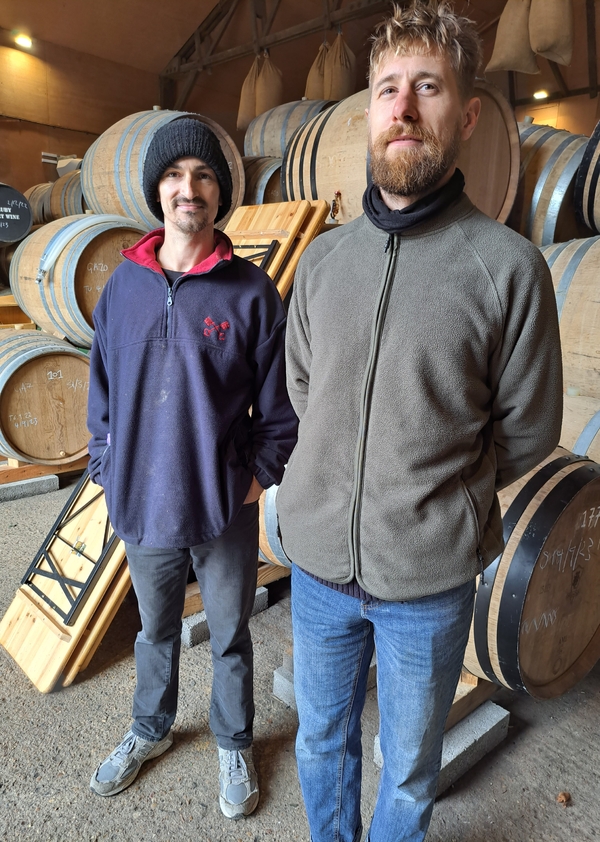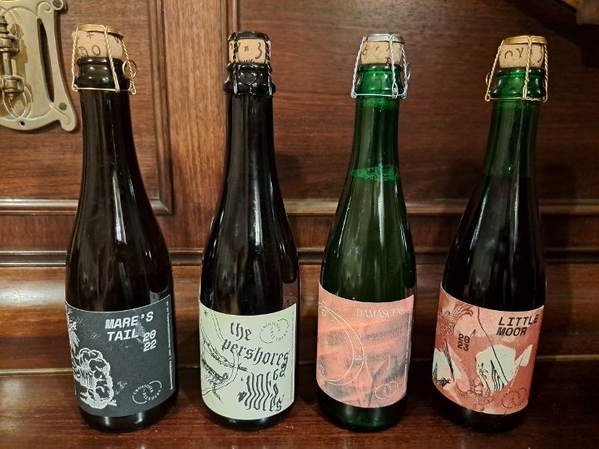Wild beers come to life down on the farm
Added: Monday, October 30th 2023

On a farm in rural Hertfordshire George Stagg (right) and Charlie Wood are producing beers inspired by an ancient form of brewing in Belgium known as lambic, the result of wild or spontaneous fermentation.
George and Charlie aren’t brewers. They worked in the City of London but were beer lovers who had an epiphany when they toured the Cantillon Brewery in Anderlecht. They saw how lambic beers are brewed, tasted the end results and decided to follow in Cantillon’s footsteps when they returned home.
They opened their blendery in a warehouse at Lannock Manor Farm close to the village of Weston in 2020. The shed is packed with more than 100 oak casks bought from a variety of sources – the French wine trade, sherry makers in Spain, port casks from Portugal, bourbon and whisky containers and even a few from mead producers.
Lambic is the world’s oldest beer style and it has existed for some 400 years. Before brewers understood the workings of yeast, tamed it and cultured it, they allowed wild strains in the air and inside brewing vessels to attack malt sugars and turn them into alcohol.
In the Payottenland area, centred on the Senne Valley, with Brussels at its heart, a small group of dedicated brewers has remained faithful to a tradition that produces beers that, with their tart, vinous and even cider-like characteristics, seem to break down all the barriers between cereal-based and fruit-based alcoholic drinks.
In recent years lambic has burst out of its Payottenland confines and has been taken up by brewers in other countries, notably Britain and the United States. Many producers call them sour beers or sours – a term disliked by the Belgians brewers.
Frank Boon, one of the most revered lambic brewers based in the village of Lembeek, which gives its name to the style, says: “My beers are not sour – they are acidic, like Brut Champagne”. Fittingly, the beer was once known as “the Champagne of the North” and it features in the paintings of the Brueghels where jolly, roistering peasants drink lambic from flagons.
At Crossover, Charlie and George produce fruit lambics and blends of beer that are between one and three years old. Blended lambics are known as gueuze – it’s thought the name comes from geyser as the beer gushes and foams when bottles are opened.
The liquid in the casks at Crossover is hopped wort brought from Elgood’s Brewery in Wisbech in the Cambridge Fens. Elgood’s is a family brewery dating from 1795. The brewhouse has two large shallow open copper vessels called coolships where hopped wort was cooled prior to fermentation. The coolships were phased out many years ago to avoid spoilage by wild yeasts but when Alan Pateman took over as head brewer he decided to bring them back into use to make his version of lambic.
Alan says his father brewed at Paine’s of St Neots, which also had coolships. He thinks the system was once widespread in eastern England with its close links to the Low Countries.
Hopped wort is the result of mashing malted barley and raw wheat to produce a sweet extract that’s boiled with hops. The liquid is then pumped to the coolships where windows are left open to encourage wild yeasts to enter and greedily attack the sugars in the wort.
The hopped wort sent to Crossover is produced to Charlie and George’s recipes. They insist on using only the finest raw materials: Maris Otter malting barley, raw wheat, English hops and “noble” varieties from the German Hallertau region in Bavaria. Adhering to strict Belgian guidelines for making lambic, the Crossover beers are a blend of 60 per cent malted barley and 30 per cent raw wheat. Hops have been aged for several years: bitterness doesn’t marry well with the acidity created by wild fermentation and the hops are used mainly for their ability to stave off unwanted infections.
The casks are thoroughly cleaned to remove all traces of wine and other alcohols: Charlie and George don’t want any notes of wine, caramel and vanilla in their beers. But however hard casks are washed, it’s impossible to get rid of the yeasts and bacteria locked in the wood.
Research at the brewing school of the University of Leuven in Belgium has identified 86 strains of wild yeast and bacteria in lambic. They include Brettanomyces, pediococcus and lactobacillus. Brettanomyces means “British fungus” and was first identified in the porter beers of the 18th century that were aged in wood. It’s the most significant yeast strain at work with lambic and gives a musty note to the beer that brewers call “horse blanket”.
Belgian lambics are famous for their fruit versions, notably with cherries and raspberries. At Crossover, Charlie and George use a wide variety of fruit, including apricots from the Isle of Wight, peaches and nectarines from Kent and plums and damsons from Worcestershire.

The fruit beers are conditioned for six months before they are packaged in 350ml and 750ml bottles. The beers are bottle conditioned and will age and mature.
The Crossover interpretations of gueuze are conditioned for a full year.
Damascene (6.5%), a beer aged with damsons, won the Hertfordshire Beer of the Year award at St Albans beer festival in September and is a blend of one, two and three year beers. It has a fresh fruit aroma balanced by biscuit grain and light hop notes. The palate is tart, acidic and fruity followed by a fruity finish with notes of honeyed grain and gentle bitterness.
Mare’s Tail (5.9%) is not fruited and is a golden ale that’s a blend of beers aged for 32 months. Jester hops from Herefordshire add a lemon and lime note. It has an acidic nose with tart fruit and notes of honeyed malt. The palate is mouth-puckeringly acidic with additional notes of fruit and hops. The finish is dry with lemon and lime fruit, spicy hops and biscuit malt.
Charlie and George are in for the long haul at Crossover. With the farmer’s support, they have planted 300 fruit trees that will give them an even greater choice of fruit in the future.
Crossover has a taproom open at weekends but it’s closed during the winter and will reopen in March. But there will be a Christmas Market on Saturday 9 December when beers can be sampled. They can also be bought at the farm on online from www.crossoverblendery.co.uk.
The beers are challenging, stimulating and add to drinkers’ knowledge and appreciation of an ancient method of making beer.
Crossover Blendery, Lannock Manor Farm, Hitchin Road, Weston, Herts, SG4 7EE.






